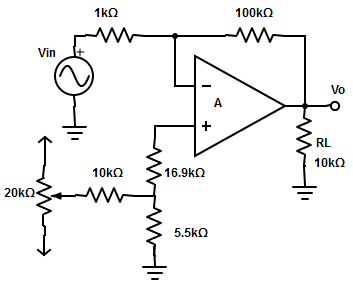11. When does the op-amp perform better?
A. Low value of SVRR in µV/V
B. High value if SVRR in µV/V
C. Low value of SVRR in dB
D. High value of SVRR in dB
12. Write the equation for change in the output offset voltage?
A. △Voo = [-RF/R1)]× [△Vio/△V] ×△V
B. △Voo = [1+(RF/R1)]× [△Vio/△V] ×△V
C. △Voo = [1+(RF/R1)]× [△Vio/△V].
D. None of the mentioned
13. A LM307 amplifier has an SVRR of 92dB, express it in terms of microvolts per volts?
A. 65µV/V
B. 37.98µV/V
C. 25.12µV/V
D. 101.4µV/V
14. Which value remains the same regardless of whether it is computed from the change in low dc supply or change in +Vcc or -Vee?
A. △V
B. △Vio
C. △Voo
D. None of the mentioned
15. Consider LM307 is initially nulled. Suppose, the op-amp has a poor filter, 20mVrms then ac ripple is measured across the terminals. If Vin=0v, determine the change in output offset voltage caused by the change in supply voltage?

A. 81µVrms
B. 8.1µVrms
C. 0.81µVrms
D. 810µVrms
16. What makes the output voltage equal to zero in practical op-amp?
A. Input offset voltage
B. output offset voltage
C. Offset minimizing voltage
D. Error voltage
17. What happens due to a mismatch between two input terminals in an op-amp?
A. Input offset voltage
B. Output offset voltage
C. Bothe the input and output offset voltage
D. None of the mentioned
18. Define the polarity of the output offset voltage in a practical op-amp?
A. Positive polarity
B. Negative polarity
C. Positive or negative polarity
D. None of the mentioned
19. The input offset voltage of 741 op-amps has an absolute maximum value of 6mv, which means
A. Minimum difference between input terminals in 741 op-amps can be large as 6mv DC
B. Minimum difference between input terminals in 741 op-amps can be large as 6mv AC
C. Maximum difference between input terminals in 741 op-amps can be large as 6mv DC
D. Maximum difference between input terminals in 741 op-amps can be large as 6mv AC
20. If three different 741 op-amps are taken and the corresponding output offset voltage for each of them is measured. The output voltage in these three op-amps have
A. Same amplitude and polarity
B. Different amplitude and polarity
C. Same amplitude and different polarity
D. Different amplitude and same polarity
21. To reduce the output offset voltage VooT to zero
A. Input offset voltage compensating network is added at the inverting input terminal
B. Input offset voltage compensating network is added at the non-inverting input terminal
C. Input offset voltage compensating network is added at the output terminal
D. None of the mentioned
22. Which of the following op-amp does not need a compensating network?
A. 777
B. 741
C. 748
D. All of the mentioned
